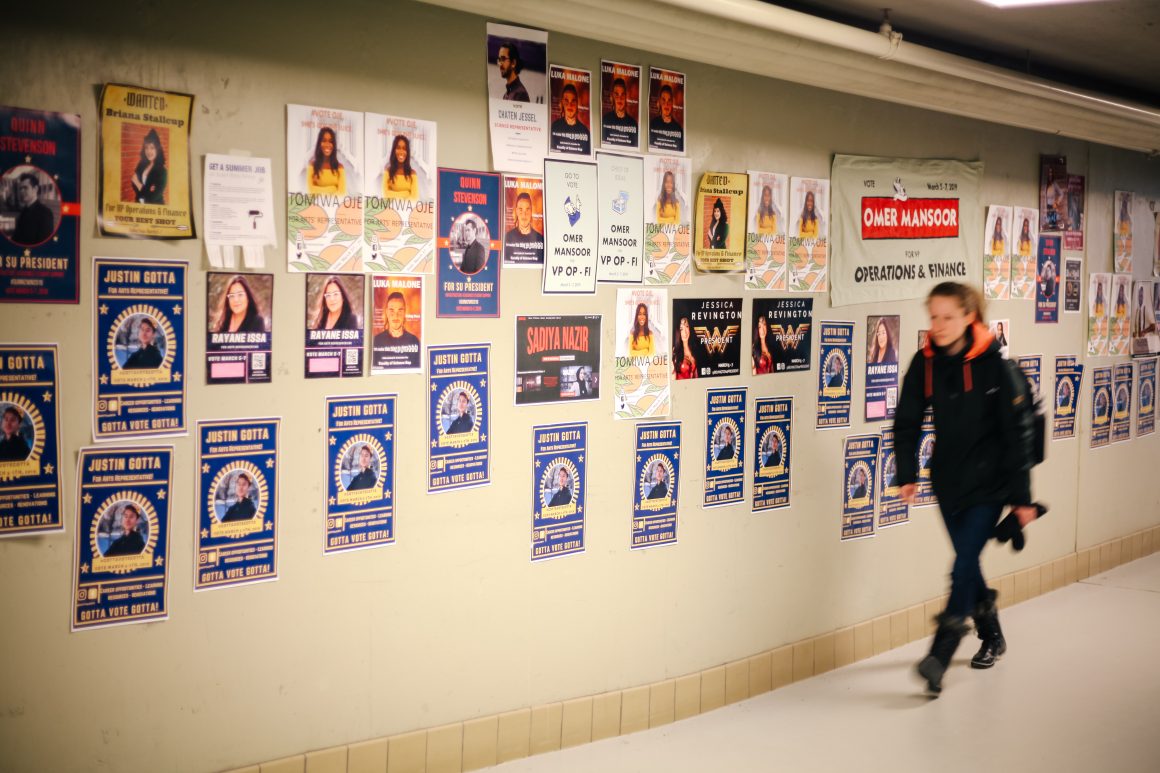
Head-to-Head: Should election campaign posters be professional or gimmicky?
Posters have too much cosplay, too little connection
By Susie Ngo, March 7 2019 —
It’s hard to miss the multitude of campaign posters plastered in every hallway from Craigie Hall to Science Theatres during the Students’ Union election. They’re big, bold and colourful, often featuring smiling candidates decked out in quirky costumes or, in one case, holding a puppy. Bearing similarities to war propaganda posters, they certainly do their job of catching people’s attention with their bright, easily recognizable graphics.
Though cute and quirky at first, some campaign cosplay posters fail to effectively deliver the platforms that candidates should be trying to spread. They don’t have enough relevant content about what the candidate is trying to get done for the student body, let alone a memorable slogan. The image built by these posters is not of a professional representative for the SU but rather someone who doesn’t realize it’s not Halloween.
The first impression made on students passing by these posters who have little background knowledge of the various candidates and their platforms is amusement, not genuine interest or consideration for issues that affect them. Having students vote for a candidate simply because they dressed up like their favourite character and not for their platforms is unsettling and reflects the depth of political inactivity within the student body. This can lead to a dangerous position in which the student body may not elect the person they need as a leader nor the platform policies they expect.
Additionally, the environmental implications of these campaign posters must also be taken into account. Each candidate is allowed up to 150 posters and two banners. With 32 candidates, this means there’s up to a whopping 4,800 pieces of paper currently scattered around the campus. Though the SU election policy gives explicit instructions on the sizing and permitted locations for the posters, I couldn’t find anything on their takedown and proper disposal. Hopefully, they are properly recycled. This raises the question of whether there are alternative campaign techniques that may be more effective and environmentally conscious than physical posters.
Despite being at school for five hours a day, five days a week, I’ve only had one SU candidate visit a class to promote their platform. Even then, he only spent about five minutes discussing what changes he wanted to make around the school. Five minutes out of the approximately 1,500 that I spend on campus is 0.003
[hr gap=”30″]
If your posters are boring, I’ve already moved on
By Derek Baker, March 7 2019 —
Ah, Students’ Union election season. Walk anywhere on campus that has a brick or tiled wall and face a bombardment of campaign posters. Candidates’ posters are decked out in cheesy campaign slogans, hoping to catch your attention long enough to remember their name when it comes time to vote.
Some people find the barrage of posters irritating. But I think it’s one of the few times during the year when the energy on campus changes from its daily monotonous grind.
Besides a handful of candidates, this year’s posters have been lacking in the entertainment department. Where are the gimmicks? If you’re brazen enough to put up 150 posters of your face throughout campus, at least make it entertaining.
There’s something to be said for candidates running a professional campaign. Once the dust of the SU election season settles, those elected will be in an important position to represent student interests.
But posters picturing a smiling candidate surrounded by a few buzzwords makes my mind scream “skip.” Part of being an elected official is engaging students. Though a funny poster by itself doesn’t correlate with how qualified the candidate is, it’s an important first step to pique the interest of students.
If you want to read a candidate’s platform, check the SU’s website. Posters aren’t the place to detail every ambitious task you’re hoping to achieve. No one should need to stop in the middle of the hallway to read a poster’s fine print to know why you’re running — that’s what talking to students, social media and forums are for.
Additionally, a good gimmick or slogan can help candidates secure votes in a crowded race. This is especially true for faculty representative positions where you can vote for more than one person, like for arts rep. Students will remember one or two candidates they really connected with — or already are friends with — but the other votes they dish out can come down to name recognition alone.
Unless the SU’s election policies drastically change, campaign posters will always be a staple of election season. Maybe I’m just old-fashioned and long for the days when cow and poop emojis, Thomas the Tank Engine and Toy Story’s Woody romped about campus, but don’t do your campaign a disservice by having a boring poster.
